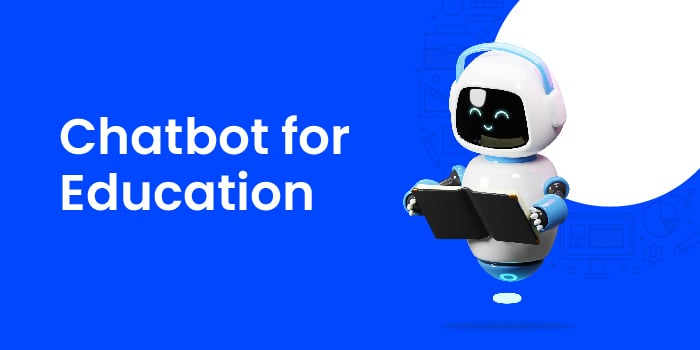In today’s digitally driven world, technological advancements continue to reshape various industries, and higher education is no exception. Chatbots for education are one such significant innovation.
Education Chatbots powered by artificial intelligence (AI) is changing the game by providing personalized, interactive, and instant support to students and educators alike. With their ability to automate tasks, deliver real-time information, and engage learners, they have emerged as powerful allies.
Let’s look at how Georgia State uses higher education chatbots to personalize student communication at scale. Say hello to “Pounce”—a custom virtual assistant for GSU admissions. Pounce was designed to help students by sending timely reminders and relevant information about enrollment tasks, collecting key survey data, and instantly resolving student inquiries on around the clock.
And these are the results they achieved –
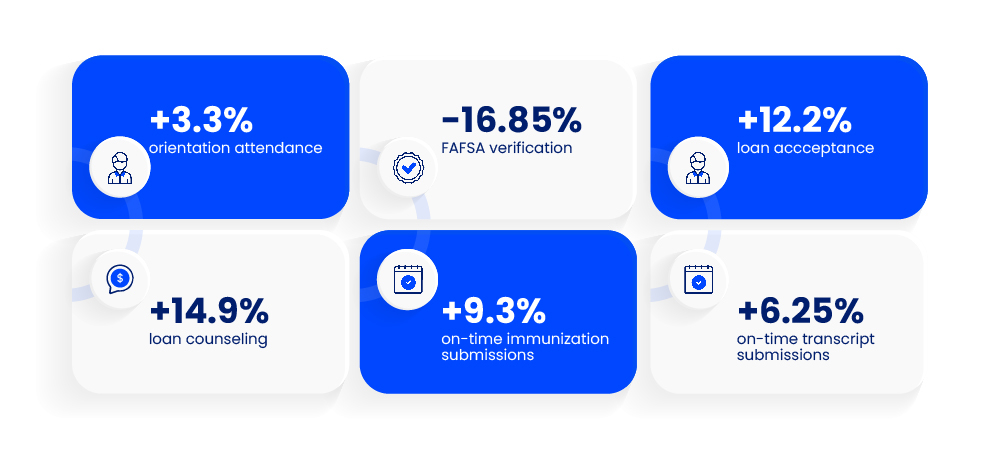
Pounce helped GSU go beyond industry standards in terms of complete admissions cycles. Because the students were better engaged, it helped them act faster.
In this article, we discuss how you can leverage chatbots to improve university enrollments, automate administrative tasks, and personalize student interactions.
4 Usecases of Chatbots for Education
There are multiple ways to leverage education chatbots to reduce your staff’s workload, help students get faster responses, and gain insights into the different aspects where human intervention isn’t required.
For example, queries related to financial aid, course details, and instructor details often have straightforward answers, or the student can be redirected towards the right page for information.
This brings me to the first use case:
1. Education chatbots to disseminate information
Let’s take a look at how you can use education chatbots to collect and disseminate information faster.
Query | How can chatbots help? | Sample question |
Course details and applications | Provide information about the available courses and answer any queries related to admissions. | What are the pre-requisites to enrol for an MBA course? |
Fees, financial aid, and payment links | Share the entire fee structure, important deadlines for payment, scholarships, and more. | How can I apply for a full scholarship? |
Campus stories | To attract the right talent and improve enrollments, colleges need to share their brand stories. Chatbots can disseminate this information when the student enquires about the college. | What kind of student clubs are there on campus? Can you share some information about on campus living? |
Virtual campus tours and school events | Before the student decides to apply for a course, parents and the student would like to know more about the campus facilities as well as the kind of exposure their child can get. Chatbots can automatically address these concerns. | I would like to take a look at the campus |
Information on course instructors | It is important for the student to know their instructors or the realities of how easy or difficult a course is. You can set up sessions with current student ambassadors to answer any queries like this. Chatbots can share their bios, set up quick chat sessions, etc. | Who teaches basics of marketing? Can I talk to someone who has taken this course recently? |
2. Chatbots to Improve Admissions Rates
Education chatbots aid the admissions process in many ways —decrease student drop-offs, shorter response times, automated follow-up reminders, and faster query resolution.
You can combine the power of chatbots with a Higher Education CRM (Customer Relationship Management) that can set up robust automations to nudge a student to complete their applications.
For example, Haptik can be integrated with LeadSquared to create a seamless and automated education workflows. Here’s how it works:
- Lead Generation: The Haptik chatbot can engage with potential students, answer their queries, and collect relevant information during conversations. This data can then be seamlessly captured in LeadSquared, where it is stored as student leads.
- Lead Nurturing: LeadSquared’s automation features enable personalized and timely communication with the collected leads. Using pre-defined workflows, send targeted reminders, notifications, and follow-up messages to nudge students towards completing their college application.
- Application Reminders: Haptik’s education chatbot integrated with LeadSquared can be programmed to send automated reminders to students who have started an application but have not yet completed it. These reminders can be triggered based on specific criteria, such as time elapsed or specific stages within the application process.
- Personalized Assistance: Haptik’s conversational AI capabilities enable the chatbot to provide personalized guidance to students. It can address individual concerns, offer support, and provide relevant information needed to complete the application successfully.
3. Interactive learning chatbots
It’s not easy for an instructor to resolve doubts and engage with every student during lectures. And setting a separate time post lectures can also get taxing for them. That’s where these learning bots can come to their rescue.
These bots engage students in real-time conversations to support their learning process. They can simulate a classroom experience, delivering personalized learning content, and adapting to individual student needs. Interactive learning chatbots can offer quizzes, exercises, and educational games, providing an engaging learning environment.
4. Assessment and evaluation chatbots
There’s one thing that professors find more time consuming than prepping for the next class—grading tests. The purpose of these assessments is to understand how well the students have grasped a particular topic. But chatbots like Quizbot can take that pain away.
Quizbot, an AI-Powered chatbot, can administer quizzes and evaluate student performances. Quizzes can be automatically created, deliver real-time feedback for wrong answers, adapt to various difficulty levels, and add a touch of gamification for improved student engagement.
These chatbots contribute to a more efficient and effective assessment process while promoting active student engagement and facilitating personalized learning journeys.
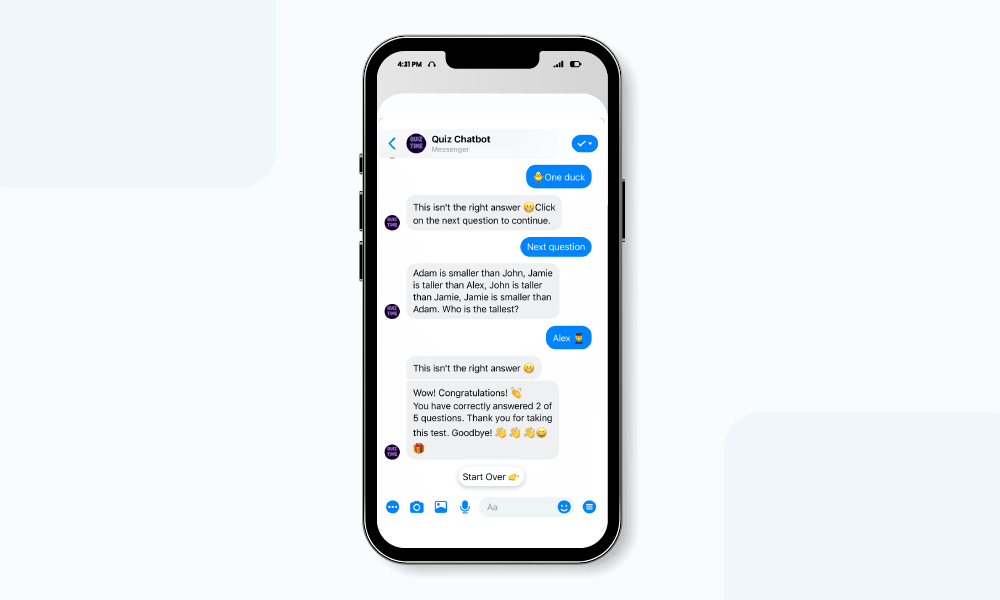
Now that you’re aware of how you can use a chatbot for your institution, let’s look at how will it benefit you in reaching your ultimate goal—more student enrollments and better student engagement!
The solution is to integrate an education chatbot with a higher-education CRM to help your admissions team create magic.
The Perfect Duo for your Admissions Teams—Education Chatbot + CRM
The most obvious benefit of using a chatbot for your admissions is all the time your admissions team will save. But let’s see how it can improve processes and metrics to help you get more student enrollments.
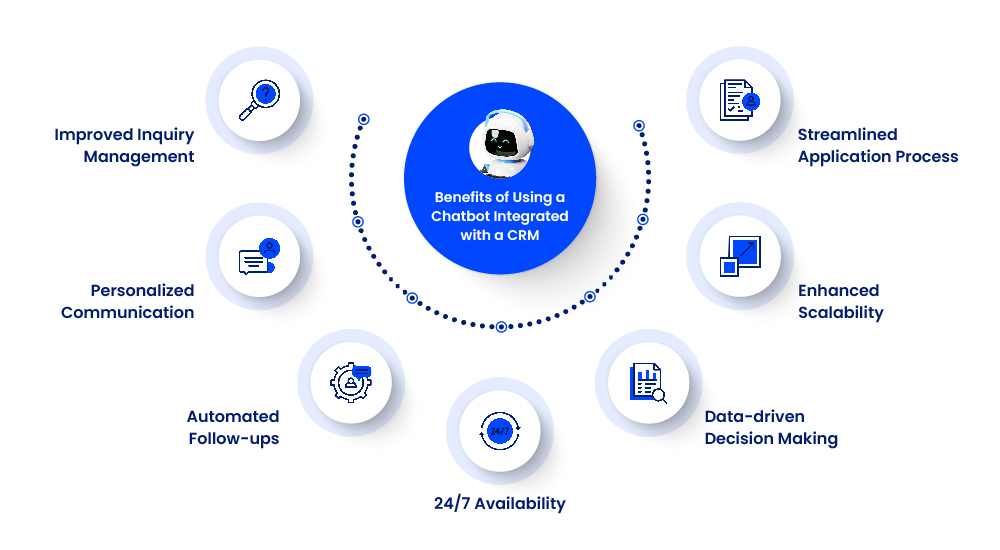
1. Improved Inquiry Management
The chatbot can engage with prospective students, answer their inquiries, and collect relevant information. This data then can be seamlessly transferred to your CRM, allowing the admissions team to manage and organize leads in a centralized system. This streamlines the student management process and ensures that no potential students slip through the cracks.
A higher-education CRM like LeadSquared can integrate with different chatbots, capture that information, and give your counseling teams a one-shot view of the student’s journey so far.
Check out how can LeadSquared for Higher Education fits the bill!
2. Personalized Communication
An AI-enabled education chatbot can deliver personalized communication and nudge the student to act faster. Remember how Pounce helped GSU get on time transcript submissions? The chatbot can not only explain the steps involved, but also save the counselor’s time on following-up for necessary documents.
And although the chatbot might be communicating at scale, for a student it feels like the chatbot is especially there to help him move along the admissions journey. This personalized approach enhances the overall user experience and fosters a stronger connection with potential students.
3. Automated Follow-ups
An integrated chatbot and CRM, enables automated follow-ups for incoming inquiries. The CRM can trigger personalized messages, reminders, and notifications to prospective students at various stages of the admissions process. This automated follow-up reduces manual efforts, and increases the chances of conversion.
4. 24/7 Availability
With a chatbot, the admissions team can provide round-the-clock support to prospective students. It can handle inquiries and provide information even outside regular office hours, ensuring that students’ questions are addressed promptly. This availability enhances student experience and reduces the response time, giving the admissions team a competitive edge.
5. Data-driven Decision Making
Effective student journey mapping with the help of a CRM offers robust analytics and insights. By integrating the chatbot’s data into the CRM, the admissions team can gain valuable insights into student’s behavior, engagement levels, and conversion rates. The team can then take data-driven decisions by identifying trends, optimizing recruitment strategies, and allocating resources effectively.
6. Enhanced Scalability
As the number of prospective students and inquiries increases, manually managing and responding to each one becomes challenging. An AI-powered chatbot can handle a high volume of inquiries simultaneously and cater to a larger pool of students without compromising the quality of engagement.
7. Streamlined Application Process
Having an integrated chatbot and CRM can streamline the application process for prospective students. The chatbot can assist students in filling out application forms, provide guidance on required documents, and offer reminders about deadlines. With automated prompts and notifications, a chatbot ensures that students complete the necessary steps in a timely manner, reducing administrative burdens for both the students and the admissions team.
But does this mean that only the admissions team and teachers can take advantage of a chatbot? Not true. Here are some of the other teams that can also take advantage of a chatbot for their processes.
Higher Education Teams That Leverage Chatbots
Besides the enrollment teams and instructors, several services can be streamlined with the help of chatbots.
1. Student Support Services
Chatbots can assist student support services teams by providing instant responses to frequently asked questions. 57% of people expect the same response times during business and non-business hours. Students want quick answers and don’t always expect a human interaction. For queries about part-time opportunities, student organizations, etc, a chatbot can guide students to the right resources and offer support for various non-academic matters.
2. Career Services
Career services teams can utilize chatbots to provide guidance on career exploration, job search strategies, resume building, interview preparation, and internship opportunities. For example, a student can interact with a career chatbot to identify different types of questions to expect for a particular job interview. It can be used to offer tailored advice based on students’ interests and qualifications and provide links to relevant job boards or networking events.
3. Library Services
Chatbots can enhance library services by helping students find books, articles, and other research materials. They can assist with library catalog searches, recommend resources based on subject areas, provide citation assistance, and offer guidance on library policies.
One such example is Beacon, the digital friend to students at Staffordshire University. It responds to 400+ student inquiries related to library services.
Chatbots can also be used to send reminders for book returns or overdue items, renew library materials, and suggest study guides or research methodologies.
4. IT Support
Chatbots can act as a first line of support for IT teams, assisting with common technical issues faced by students and staff. How many times has it happened with you that your library computer kept glitching and students couldn’t submit your paper on time?
Chatbots can troubleshoot basic problems, guide users through software installations or configurations, reset passwords, provide network information, and offer self-help resources. IT teams can handle a large volume of easy-to-resolve tickets using an education chatbot and reserve their resources for complex issues that require human support.
I think you seem convinced that using a chatbot for education at your institute will prove beneficial. So let me also help you with a few education chatbot templates to get you started.
7 Effective Education Chatbot Templates
Here is a list of your holy grail templates to get started with while implementing a chatbot for your admissions workflow: –
1. Admission Inquiry
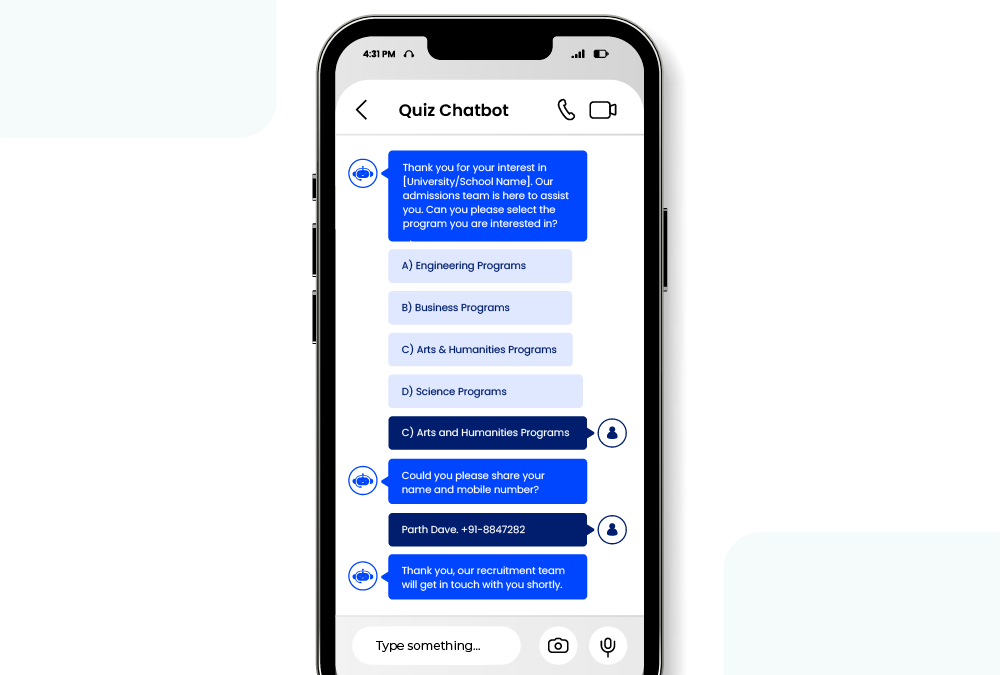
2. Course Details
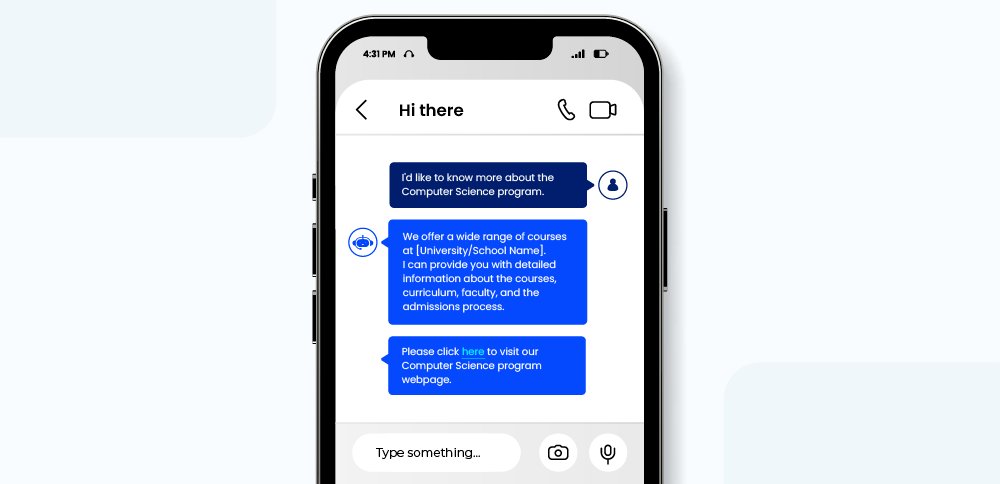
3. Financial Aid Details
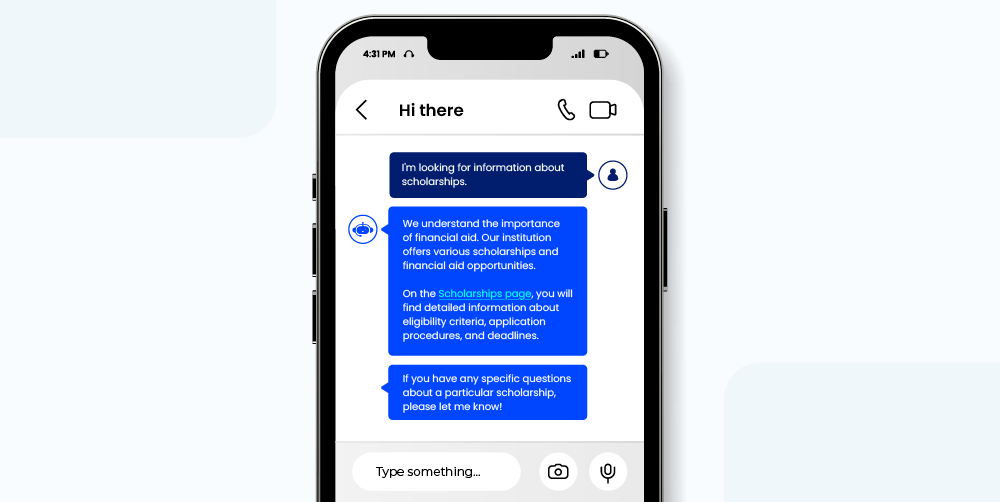
4. Reminders to Complete Application
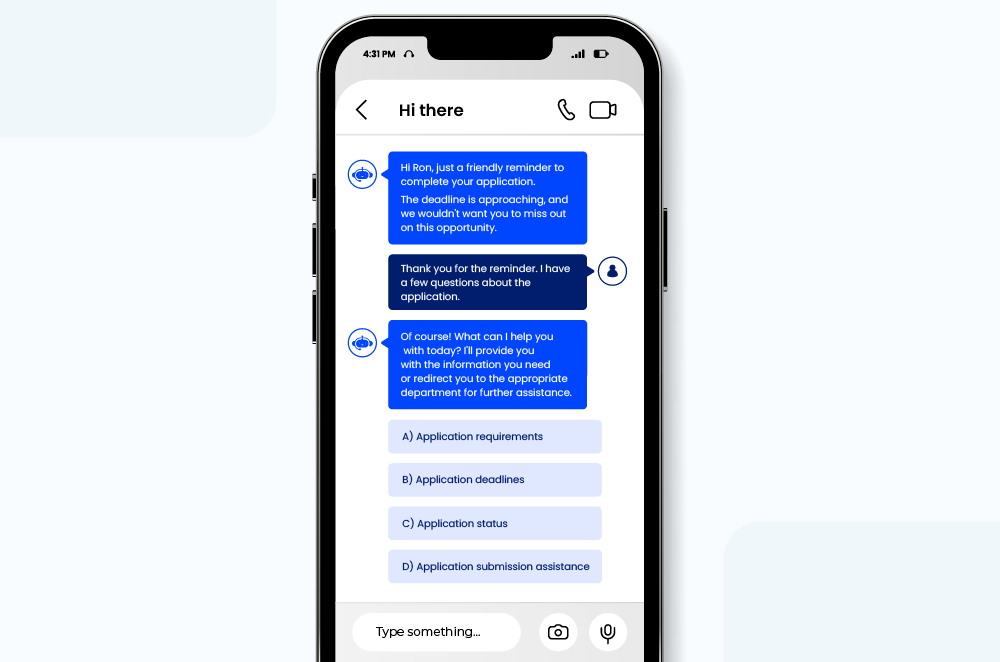
5. Fee Payments
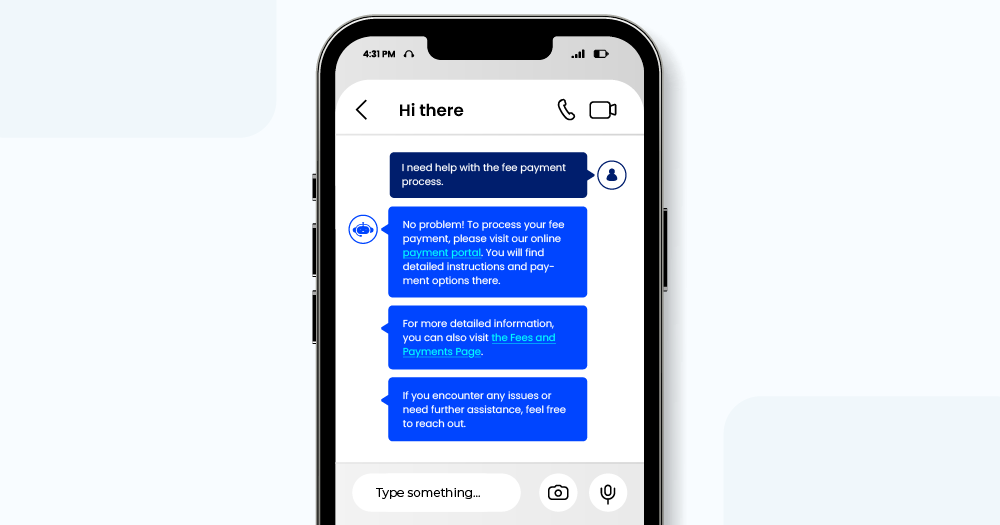
6. Virtual Campus Tour Appointment
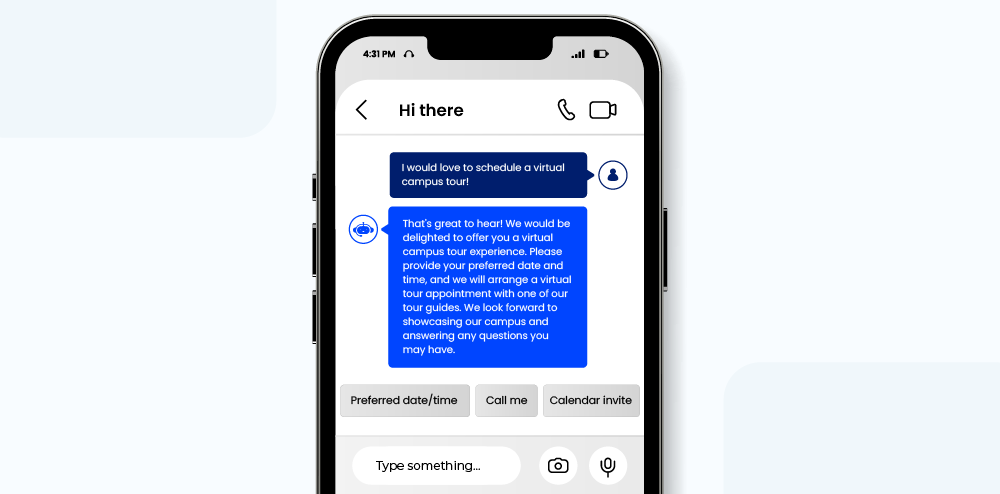
Top 5 Chatbots for Education
Now that you have your templates handy, let’s set up a chatbot for your higher education institution. Here’s a list of chatbots you can choose from:
1. Haptik
Haptik offers customized solutions for educational institutions to provide personalized assistance to students, handle admissions inquiries, guide them through the application process, and more.
⭐Key Feature: Offers a highly customizable chatbot platform with advanced natural language processing (NLPs) capabilities, allowing educational institutions to create personalized and interactive experiences for students.
Pro: It integrates seamlessly with various channels such as the LeadSquared CRM, websites, mobile apps, and messaging platforms, ensuring a consistent and accessible user experience.
Con: Occasional delays in response time during peak usage periods.
“Haptik provides simple and intuitive bot building experience with really great Analytics engine baked in the product which helps getting insights that would otherwise have had to be built by developers.”
Utkarsh K. (via. G2)
2. IBM Watson Assistant
IBM Watson Assistant helps answer student queries, provides course information, assists with research, and offers personalized recommendations for academic resources.
⭐ Key Feature: Leverages advanced AI capabilities and responds to queries with close to 100% accuracy. It also maintains every chatbot instance on a single interface.
Pro: The platform’s ability to integrate with other IBM services and solutions allows for seamless data sharing and collaboration if the institution is using IBM services in their existing infrastructure.
Con: Initial setup and training process for the chatbot can be time-consuming and require technical expertise.
“IBM Watson Assistant is great for creating simple chatbots. However, it can struggle a bit when things start to get complex. Integrating it with third-party apps is tough if they are not directly supported. And the documentation could improve further.”
verified user (via. G2)
3. Ada Support
Ada Support offers automated support to students, answers frequently asked questions, assists with enrollment, and provides real-time guidance on various academic matters.
⭐ Key Feature: Excels in its ability to provide personalized and context-aware responses to student inquiries through its AI-powered chatbot. Since 90% of inquiries get resolved through Ada, counselors can spend time in resolving more complex student inquiries.
Pro: Has a user-friendly interface and ease of customization, allowing institutions to tailor the chatbot to their specific needs and branding.
Con: Challenges in fine-tuning the chatbot’s responses to ensure accuracy for niche or specialized queries.
“Their reporting is also lacking – we’ve had to ask them to email us an export at regular intervals (that’s currently the only way for some reports) and do most of our in-depth analysis manually in Excel.”
Louis K (via. G2)
4. Ivy.ai
Ivy.ai is specifically developed for higher education. It supports students by providing information on admissions, course details, financial aid, campus services, and academic resources. It can handle complex student inquiries.
⭐Key Feature: Provides a personalized and conversational experience for students, offering AI-powered support throughout the student lifecycle, from admissions to graduation.
Pro: Helps capture and get insights into the specialized needs of the students.
Con: The implementation process and initial training of the chatbot can require dedicated resources and expertise.
“I wish I could attach documents to the chat so that the student had ALL of the information they need: the form, the process, and where to submit their request.”
Raquel.A (via. G2)
5. Botpress
Botpress is an open source chatbot framework. It offers flexibility and customization options, allowing institutions to build and deploy their own chatbot solutions tailored to their specific needs.
⭐ Key Feature: Being an open-source platform makes Botpress highly adaptable to the institution’s unique needs.
Pro: Extensive customization and integration possibilities, making it a flexible solution for institutions with specific technical requirements.
Con: Support and maintenance may rely on the institution’s technical team or external developers.
“Very difficult to run multiple instances from one installation. Beginners learning curve could be an obstacle.”
verified user (via. G2)
Wrapping Up
I hope this extensive guide on chatbots helped you understand why it is necessary to implement this solution for your institution. It can not only help you save your counsellor’s time but also make it possible for them to build a better rapport with the prospective students.
For the best outcomes, it is important to capture these insights and map them to your CRM to get qualitative insights that help you engage with students better and guide them throughout their journey at university.
LeadSquared’s higher education CRM helps institutions drive paperless admissions, map student individual student journeys to ensure personalized communication, and eliminate counselor distractions by prioritising important student inquiries.
You can check out how LeadSquared for Education can help you map and manage the entire admission lifecycle for a prospective student.







